Article
Continental AC System diagnostic
Included in Continental HVAC
Home HVAC System Diagnostic Check
A well-maintained HVAC system keeps your home comfortable year-round, improves indoor air quality, and increases energy efficiency. Regular diagnostic service checks help ensure your system is working optimally, reduce costly breakdowns, and extend the lifespan of the unit. Heres a breakdown of what you can expect in a standard HVAC system diagnostic service check.
1. Thermostat Check and Calibration
The thermostat is the control center of your HVAC system. During a diagnostic check, the technician will inspect and calibrate the thermostat to ensure its reading the correct temperature and accurately controlling heating and cooling cycles. This prevents unnecessary energy consumption and keeps indoor temperatures comfortable.
2. Inspecting and Replacing Filters
Clean filters are crucial for efficient airflow and indoor air quality. A diagnostic check includes inspecting air filters and, if necessary, replacing them. Dirty filters force the HVAC system to work harder, increasing energy costs and putting undue strain on the system, which can lead to premature wear.
3. Checking Electrical Components
Electrical components, like wiring, relays, and circuits, need regular inspection to ensure safe and smooth operation. The technician will inspect all electrical connections, tighten loose wires, and replace any damaged or worn components. This part of the check also helps prevent potential electrical hazards.
4. Inspecting the Condenser and Evaporator Coils
Condenser and evaporator coils are essential for effective heating and cooling. Dust and dirt can accumulate on these coils, reducing their efficiency and potentially causing the system to overheat or freeze. The technician will inspect and clean these coils to ensure optimal performance.
5. Refrigerant Level Check
The HVAC systems refrigerant level must be at a specific level for efficient operation. Low refrigerant can strain the compressor and cause cooling issues, while too much refrigerant can also damage the system. During a diagnostic check, the technician will verify refrigerant levels and add or remove refrigerant as needed.
6. Inspecting the Blower Motor and Fan
The blower motor and fan move air through the ductwork. If they arent working properly, your HVAC system wont circulate air effectively. The technician will check for motor wear, clean fan blades, and ensure the blower is running efficiently, helping prevent overheating and maintaining consistent airflow.
7. Ductwork Inspection
Leaks, blockages, or debris in the ductwork can reduce airflow and make your HVAC system work harder to heat or cool your home. The technician will inspect ductwork for leaks, clean out any debris, and ensure ducts are free from obstructions to improve system efficiency.
8. Checking the Drainage System
The HVAC system removes moisture from the air, which collects in the drainage system. Clogged or damaged drains can lead to water damage, mold growth, and system malfunctions. The technician will inspect the drainage system, clear any clogs, and ensure condensate lines are free-flowing to prevent water buildup.
9. Testing System Performance
After completing all individual checks, the technician will test the HVAC system as a whole. This performance test includes running the system through heating and cooling cycles to verify it operates smoothly, cycles correctly, and produces the expected temperature changes. Any unusual sounds, smells, or performance issues are noted and addressed.
10. Providing a Service Report and Recommendations
Following the diagnostic check, youll receive a service report detailing the technicians findings, including any recommended repairs, part replacements, or maintenance tips. This ensures youre fully informed of the systems health and any actions needed to keep it in optimal working order.
Summary
Regular diagnostic checks help ensure your HVAC system operates at peak efficiency, saves energy, and maintains indoor comfort. Scheduling this service at least once a year, typically before peak heating or cooling seasons, can prevent unexpected breakdowns, reduce repair costs, and extend your systems life. An experienced HVAC professional can guide you through the inspection process and offer personalized tips to improve efficiency and save on energy bills.
By understanding whats included in a standard HVAC diagnostic check, you can make more informed decisions about maintaining your homes heating and cooling system.
Remember this much
Regular diagnostic checks help ensure your HVAC system operates at peak efficiency, saves energy, and maintains indoor comfort. Scheduling this service at least once a year, typically before peak heating or cooling seasons, can prevent unexpected breakdowns, reduce repair costs, and extend your systems life. An experienced HVAC professional can guide you through the inspection process and offer personalized tips to improve efficiency and save on energy bills.
By understanding whats included in a standard HVAC diagnostic check, you can make more informed decisions about maintaining your homes heating and cooling system.
Continental Airduct on EaglesWing

share this
Related Articles
Related Articles
STAY UP TO DATE
GET PATH'S LATEST
Receive bi-weekly updates from the church, and get a heads up on upcoming events.
Contact Us






